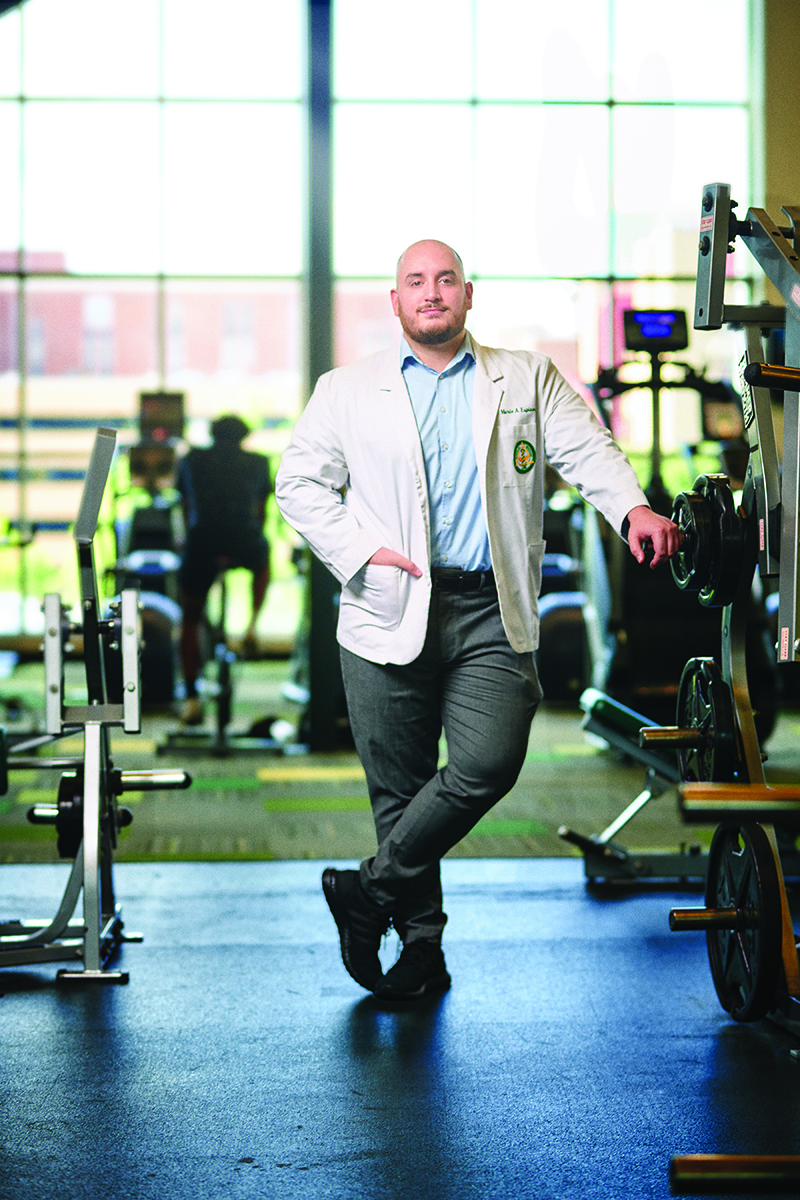In February 2022, Mario Andres Espinosa Hernandez was nearing graduation from the UAB Heersink School of Medicine and was looking forward to Match Day in March, when he would learn where he has matched into residency. However, there was one more challenge for him to overcome—one that arrived unexpectedly and with higher stakes than any he had previously encountered.
It was an ordinary Tuesday when Espinosa Hernandez headed to the gym to work out. There, something happened that changed two lives in dramatic ways. “I was doing my workout, and out of the corner of my eye I saw my friend crouched over a girl who was lying on the floor, and he was motioning for me to come over,” Espinosa Hernandez says. “It looked like she was having a seizure.”
Leaning into his medical school training, Espinosa Hernandez says he thought about the ABCs (airway, breathing, circulation), felt for a pulse (which he says was “very thready”), and began performing the jaw thrust maneuver to open her airway. A nurse who also happened to be at the gym hurried over to help. A few minutes later, Espinosa Hernandez saw that the woman’s face, lips, and fingers were turning blue, and he checked her pulse again and found none. He asked the nurse to begin CPR and asked another person to get one of the gym’s automated external defibrillators (AEDs). When they removed the woman’s shirt to place the AED pads, he noticed a long scar running down her chest. “I saw that and thought, ‘Oh no, this might be cardiac. It could be very serious.’” Indeed, once applied the AED diagnosed that the young woman’s heart was in a fatal arrhythmia.
It was a moment that could have triggered what Espinosa Hernandez says medical students call “imposter syndrome”—the feeling that, regardless of all the training, you’re not truly prepared to handle a life-or-death situation. Instead, he says the opposite sensation kicked in. “I didn’t have time to be scared or nervous. My brain was like, ‘You’ve done the simulations. You’ve had the training. You know what needs to be done, and she may die without it.’”
 Mario Andres Espinosa Hernandez
Mario Andres Espinosa Hernandez
Espinosa Hernandez says he shocked her three times with the AED before the emergency medical system (EMS) team arrived. EMS shocked her again, finally bringing the woman back to a regular heart rate before rushing her to the ambulance.
Only then did the enormity of what had just happened hit Espinosa Hernandez. “When I knew she was at least temporarily stabilized, all of the emotions flooded in,” he says. “I was shaking, and it seemed like the entire gym walked up to me, asking me questions and calling me a hero. It was insane.”
Knowing his quick reactions had helped save a young woman’s life would have boosted the confidence of any medical student, but it held particular significance for Espinosa Hernandez. Growing up, he helped care for his mother, who suffers from multiple sclerosis. The two watched a lot of medical shows together, and he says he was hooked. “My mom would call me her little doctor,” Espinosa Hernandez, whose family is from Puerto Rico, says. “I knew medicine was what I needed to do. I wanted to help people.”
Not surprisingly, Espinosa Hernandez’s first call after helping save the young woman’s life was to his mother. “We were both on the verge of tears, because she’s my motivation for everything,” he says. “She told me she always knew I had it in me and said she was really proud of me. It made me feel, ‘I need to do this.’” He says he felt in those moments like he genuinely belongs in medicine.
That hasn’t always been the case. Espinosa Hernandez admits he occasionally struggled with doubt and insecurity while in medical school. “I sometimes had feelings of, ‘I’m different than a lot of the other medical students, I’m from Puerto Rico, I come from a low-income household.’ I thought maybe I didn’t really belong,” he says. “But I will always love UAB, because UAB was the medical school that gave me a chance. And then this happened, and it definitely gave me a boost of confidence.”
For several weeks, Espinosa Hernandez did not know the fate of the woman he had helped keep alive, until one day a staff member at the gym told him that her father was trying to track him down. “I called him, and it was very emotional,” he says. “He filled me in on a lot of details. She has a congenital heart disease called Tetralogy of Fallot, and she had had open-heart surgery when she was 15 or 16 months old. She was actually scheduled to have another heart procedure done before the incident at the gym happened.”
Espinosa Hernandez learned that the woman spent several days in the ICU before being transferred to the hospital where her heart surgeon practices. Her father told him she had had the scheduled heart procedure and was home recovering well.
Today, Espinosa Hernandez has started residency training at the University of Florida in Gainesville. His specialty is an appropriate one: emergency medicine. “Maybe this is cheesy, but when I was a kid taking care of my mom, I really wanted to be a hero. One of the reasons I wanted to go into emergency medicine is I wanted to know what to do in case of an emergency, and this scenario has showed me that I achieved my dream.” – Rosalind Fournier